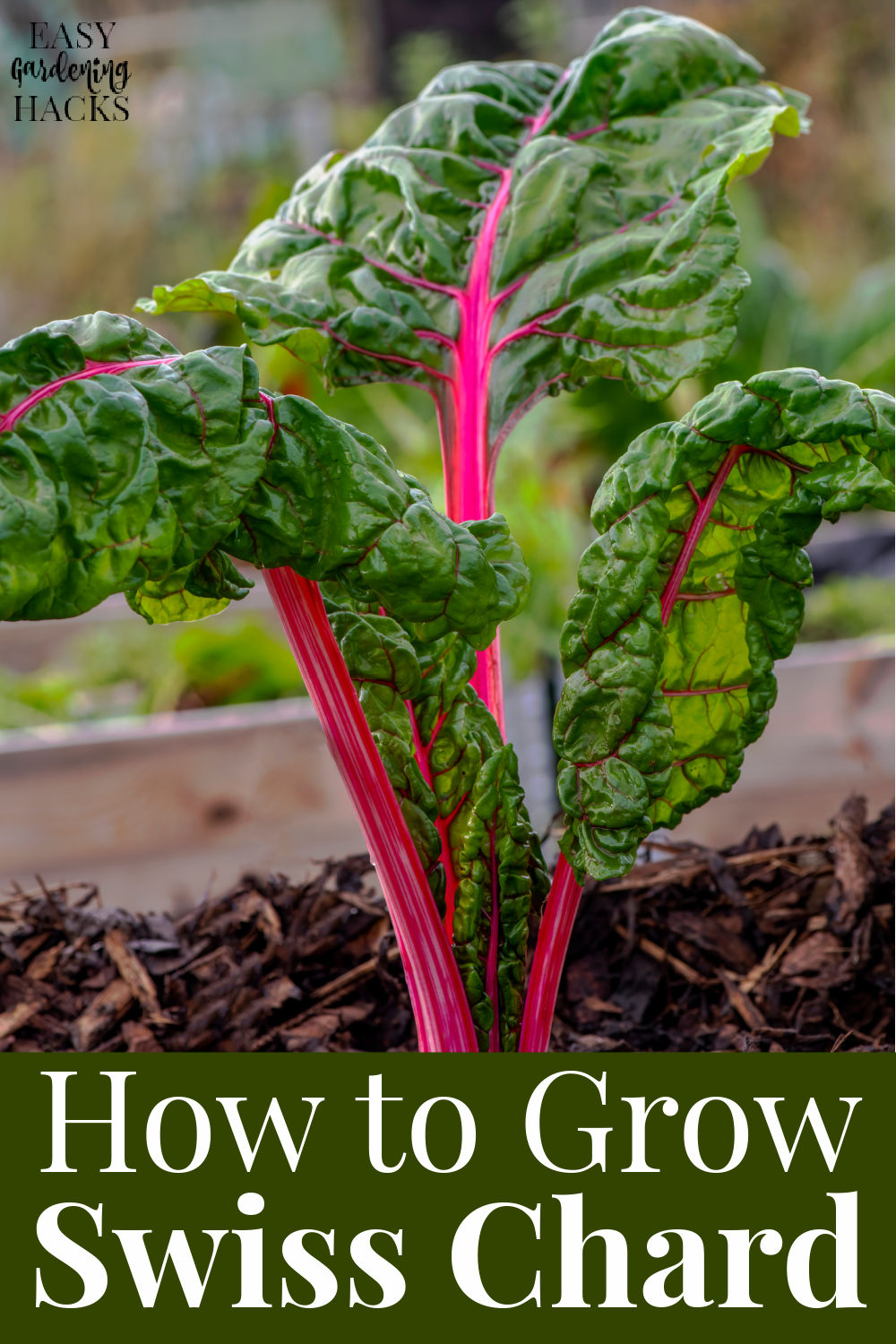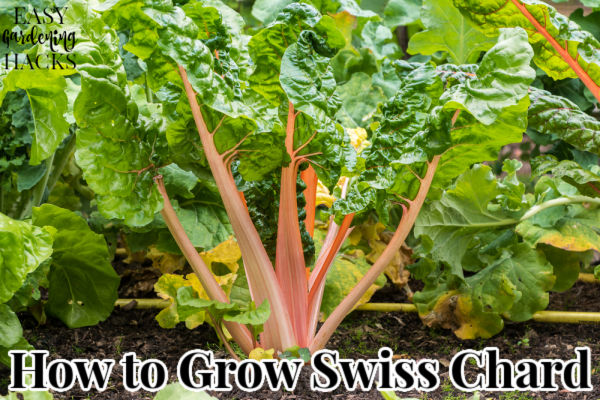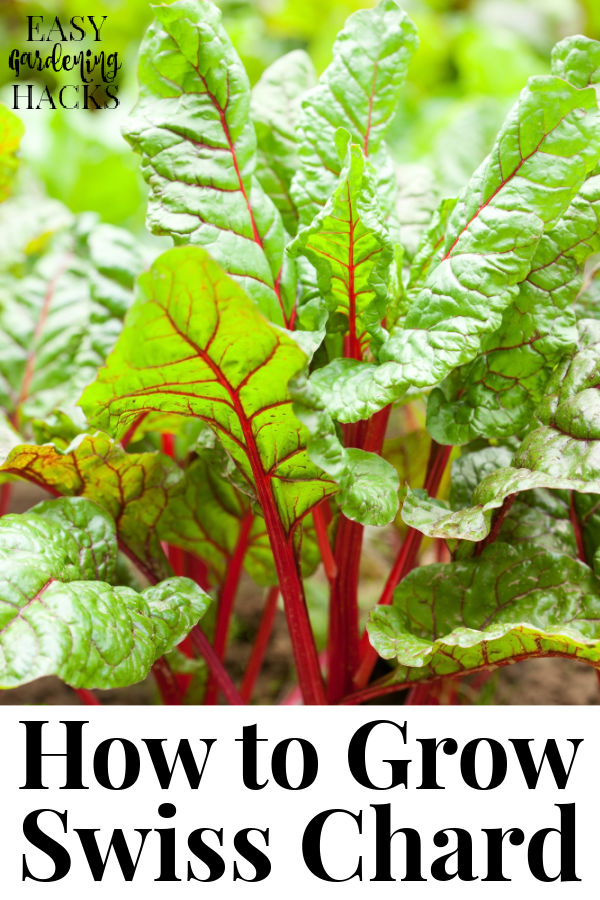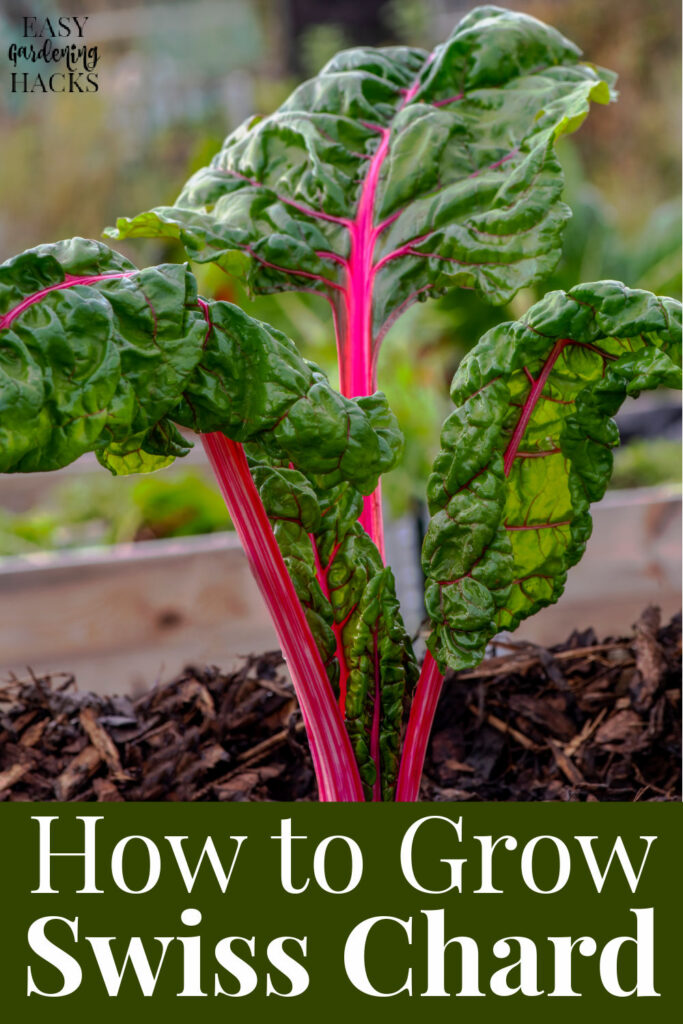Use these tips on how to grow Swiss Chard to add this cold-hardy vegetable to your garden. The tips include everything from sowing chard seeds to harvesting the colorful stems and green leaves.

How to Grow Swiss Chard
There’s nothing quite as beautiful as a bunch of Swiss chard on a plate. Since it comes in a rainbow of colors you can make a dish salad greens look amazing. Swiss Chard is also very versatile and you can use both the stalks and the leaves in recipes. Did you know that Swiss Chard is a member of the beet family? if you would like to grow some Swiss chard for your family, check out these tips on how to grow Swiss chard from transplanting seedlings all the way to harvesting.
Swiss chard grows best in full sun but can be planted in an area that gets partial shade. Chard needs well-drained soil. It also needs nutrient-rich soil. I like to mix compost into my soil before planting, but you can mix other organic matter.
How to Grow Swiss Chard From Seeds
To start Swiss chard inside before the last frost, you will need a seed starting tray and seedling starting mix for the soil. Poke your finger into the soil to make a hole 1/2 inch deep, and place 1-2 seeds inside, then cover with soil. Water until wet and cover with a clear cover or some plastic wrap. Place the trays in a warm, sunny location. Water as needed to keep the soil moist. Seeds will germinate in about a week.
You can directly sow chard seeds in a sunny spot in your garden after the last frost as long as the soil is at least 50 degrees Farenheight. Plant seeds 1/2 inch deep in well-drained soil. Plan for each plant to be placed a minimum of 6 inches apart. You can do that from the beginning or sow seeds closer and then thin the seedlings later.
If you want to grow Swiss chard as a winter crop, sow the seeds outside a month before the first frost date of fall.
For more in-depth instructions on how to grow Swiss chard from seeds, check out this guide to starting Swiss chard from seed.
How to Transplant Swiss Chard Seedlings
First, before you move seedlings that have been started inside out to the garden, the soil should be between 50 and 80 degrees Fahrenheit. Harden off seedlings that have been started inside.
Once the chart plantings are ready to be moved to the garden, dig holes just deep enough for the roots to fit. Gently remove your seedlings and place them in the holes. Add soil around but do not pack it in. Water until moist.
For more in-depth instructions on how to transplant Swiss chard seedlings, check out this post.
How to Thin Out Swiss Chard
Finding out Swiss Chard is similar to transplanting seedlings. First, notice where two or more plants are growing together in your rows. Gently dig around to find where the roots are. Remove them from the ground with a gentle hand. Take special care not to rip them out of the ground too roughly. Shake the roots gently, and you will see the Swiss chard plants separate themselves. You can help them a little bit if you need to. Keep your Swiss chard about 6 to 12 in apart. Place thinned plants in a separate hole and gently place soil around.

How to Deal with Pests on your Swiss Chard
Slugs and aphids will be your most common enemies. There are many natural ways to deal with them and prevent them, even.
The best way to deal with slugs is to prevent them. You can do this by making sure to do a good spring cleanup of any moist areas. This is where they like to lay their eggs. You can also try spraying your plants with an alcohol solution as this will keep them away.
The Old Farmer’s Almanac has some great tips on preventing and getting rid of slugs.
Aphids also do not like alcohol. You can mix alcohol and dish soap to create an aphid spray. This spray also works well on other pests. Find out how to deal with aphids with these instructions from The Old Farmer’s Almanac.
Powdery Mildew is quite common in humid locations. Counterintuitively, I have found that watering from above can wash the powdery mildew off the leaves.
If you need to treat powdering mildew, you can use a Baking Soda Spray made of 1 tablespoon baking soda, 1 tablespoon vegetable oil, and 1 teaspoon dish soap in 1 gallon of water. Mix well and spray on plants. Be careful because baking soda can burn plants and it can build up in the soil. You can find more remedies for powdery mildew with these tips.
Downy Mildew is surprisingly not a fungus. It is actually more of an algae than a fungi. According to Purdue, a simple way to prevent Downy Mildew is to water the plants in the late afternoon. If you have a history of Downy Mildew, you may want to use Neem Oil as a preventative and again at the first sign of Downy Mildew.
Unfortunately, many pests can overwinter on decaying plant material and in the soil, so be sure to remove diseased plants immediately and clean out your garden at the end of the season.

How to Harvest Swiss Chard
When do you harvest Swiss Chard?
Many people wait until their plants are 8 to 12 inches tall to harvest the leaves and ribs. However, you can begin harvesting Swiss chard as soon as the leaves are tender enough to eat. You can begin harvesting the baby leaves at around 30 days. Some people prefer the baby leaves because they have not yet developed the thick midrib. If you want large leaves with a thick rib, wait for 45- 60 days.
How do you pick chard so it keeps growing?
Swiss Chard is great because you can get several harvests out of one growing season. To do so, simply take the oldest largest outer leaves first, and leave the smaller tender leaves to grow larger. All you need is a pair of shears or a sharp knife to cut the older leaves about 2 inches above the ground.

Leave a Reply